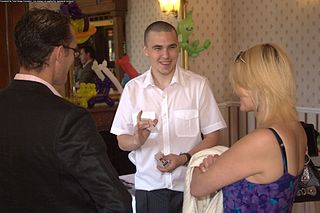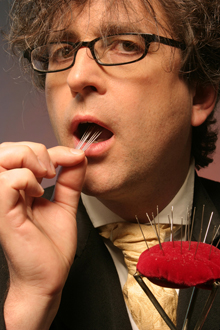Related Research Articles

Blackjack is a casino banking game. It is the most widely played casino banking game in the world. It uses decks of 52 cards and descends from a global family of casino banking games known as Twenty-One. This family of card games also includes the European games Vingt-et-Un and Pontoon, and the Russian game Ochko. Blackjack players do not compete against each other. The game is a comparing card game where each player competes against the dealer.
Pai gow poker is a version of pai gow that is played with playing cards, instead of traditional pai gow's Chinese dominoes. The game of pai gow poker was created in 1985 in the United States by Sam Torosian, owner of the Bell Card Club.
Sleight of hand refers to fine motor skills when used by performing artists in different art forms to entertain or manipulate. It is closely associated with close-up magic, card magic, card flourishing and stealing. Because of its heavy use and practice by magicians, sleight of hand is often confused as a branch of magic; however, it is a separate genre of entertainment and many artists practice sleight of hand as an independent skill. Sleight of hand pioneers with worldwide acclaim include Dan and Dave, Ricky Jay, Derek DelGaudio, David Copperfield, Yann Frisch, Norbert Ferré, Dai Vernon, Cardini, Tony Slydini, Helder Guimarães and Tom Mullica.

Card counting is a blackjack strategy used to determine whether the player or the dealer has an advantage on the next hand. Card counters are advantage players who try to overcome the casino house edge by keeping a running count of high and low valued cards dealt. They generally bet more when they have an advantage and less when the dealer has an advantage. They also change playing decisions based on the composition of the deck.

Card manipulation is the branch of magic that deals with creating effects using sleight of hand techniques involving playing cards. Card manipulation is often used in magical performances, especially in close-up, parlor, and street magic. Some of the most recognized names in this field include Dai Vernon, Tony Slydini, Ed Marlo, S.W. Erdnase, Richard Turner, John Scarne, and Ricky Jay. Before becoming world-famous for his escapes, Houdini billed himself as "The King of Cards". Among the more well-known card tricks relying on card manipulation are Ambitious Card, and Three-card Monte, a common street hustle also known as Find the Lady.
Second dealing is a method of manipulating a deck of cards during a card game by way of dealing the second, rather than the top card of the deck, usually for the purpose of cheating. Second dealing and bottom dealing are also used in performance magic.
Darwin Ortiz is a magician, who is an authority on gambling and card manipulation.
The Ambitious Card, or Elevator Card, is a magic effect in which a playing card seems to return to the top of the deck after being placed elsewhere in the middle of the deck. This is a classic effect in card magic and serves as a study subject for students of magic. Most performing card magicians will have developed their own personal Ambitious Card routine.

Cardistry is the performance art of card flourishing. Unlike card magic, cardistry is meant to be visually impressive and appear very hard to execute.

David Frederick Wingfield Verner, better known by his stage names Dai Vernon or The Professor, was a Canadian magician.
Bottom dealing or base dealing is a sleight of hand technique in which the bottom card from a deck of playing cards is dealt instead of the top card. It is used by magicians as a type of card illusion, and by card sharps and mechanics, and as a method of cheating in poker or other card games.
This is a glossary of conjuring terms used by magicians.
The Magician's Palm is a method for hiding a playing card, in which the card is placed in the hand lengthwise, the hand is curled inward slightly, and the card is thus retained in the hand. It is important with this palm that you do not have one's thumb sticking out as if "hitchhiking" as this is a "tell" or sign that a card is being palmed.

The Expert at the Card Table, is an extensive book on the art of sleight of hand published in 1902 by S. W. Erdnase, a pseudonymous author whose identity has remained a mystery for over a century. As a detailed manual of card sharps, the book is considered to be one of the most influential works on magic or conjuring with cards.

Close-up magic is magic performed in an intimate setting usually no more than 3 meters from one's audience and is usually performed while sitting at a table.
S. W. Erdnase is a pseudonym used by the author of The Expert at the Card Table, a book detailing sleight of hand, cheating and legerdemain using playing cards. Still considered essential reading for any card magician, the book has been in publication since 1902. Erdnase's true identity is one of the enduring mysteries of the magic community.

David Ben is a Canadian stage magician, sleight of hand artist, illusionist, author, publisher, keynote speaker, magic historian, magic consultant, magic collector and former tax lawyer.

Magicana is a Canadian federally incorporated not-for-profit arts organization dedicated to the study, exploration and advancement of magic as a performing art. Magicana is governed by a volunteer board of directors. Julie Eng serves as Magicana's executive director and David Ben as its artistic director.

The art form of card flourishing, commonly referred to as cardistry, grew out of simple flourishes used in close-up magic by magicians in the 1990s to early 2000s. Chris Kenner's notable two-handed Sybil cut from his 1992 publication Totally Out of Control has carried great influence and gave birth to a series of advanced flourishes which today represents the foundation of the performance art. Sleight of hand pioneers Dan and Dave Buck popularized cardistry on the world stage with their instructional DVD releases from 2004 and 2007. Journalist Kevin Pang of Vanity Fair characterized the art of card flourishing as, "It's yo-yo tricks performed by cardsharps with the street cred of a Parkour video. There's a name for it: cardistry."
References
- ↑ Erdnase, S. W. (1995) [1902]. The Expert at the Card Table. 978-0486285979. ISBN 978-0-312-09771-4.Erdnase System of Palming, pp. 48-53.